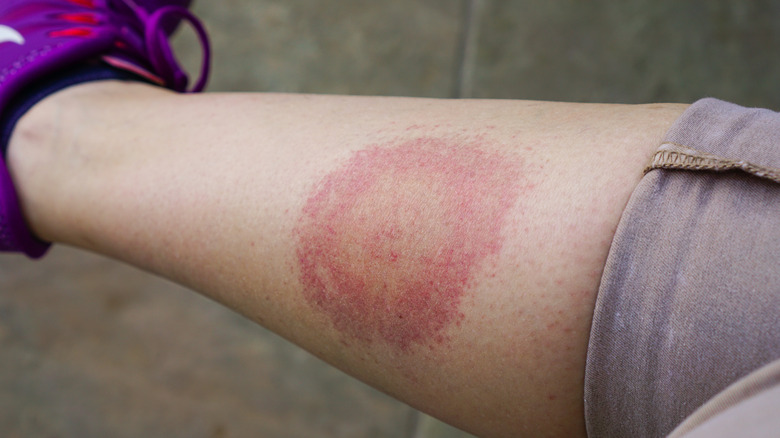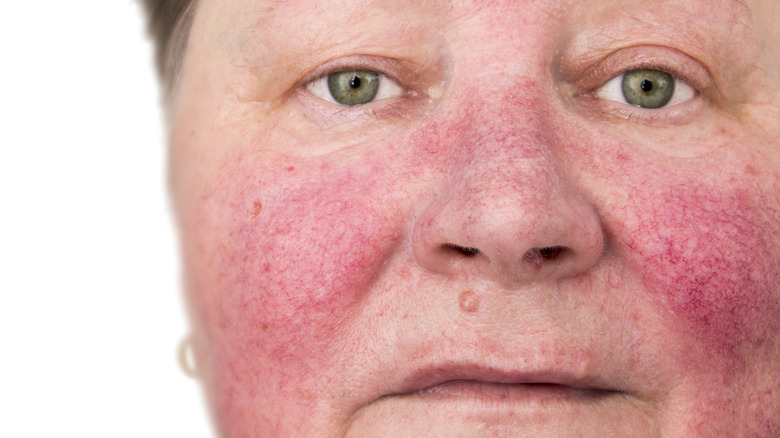Doxycycline Explained: Usage, Doses, And Side Effects
Doxycycline is a broad-spectrum antimicrobial drug used to treat a variety of bacterial and parasitic infections, according to a 2016 review in Expert Opinion on Drug Safety. Doxycycline kills microbes because it prevents them from making proteins, which prevents them from growing. It is a synthetic modification of tetracycline, a type of antibiotic naturally produced by many Streptomyces bacterial species, explains a 2001 review in Microbiology and Molecular Biology Reviews.
There are many advantages to using doxycycline to treat infections (per Expert Opinion on Drug Safety). Doxycycline kills a range of microbes, including bacteria that cause sexually transmitted infections, Lyme disease, and skin infections, as well as parasitic diseases such as malaria and river blindness. It works effectively, is cheap, patients can take it just once or twice a day, and it causes very few adverse effects. However, there are some restrictions on prescribing doxycycline to pregnant women or children. Let's dig into everything you need to know about this common antibiotic (per K Health).
Doxycycline can treat rickettsial diseases
Rickettsial diseases are a group of infections caused by various members of the bacterial order Rickettsia, according to the National Library of Medicine. While there are several distinct rickettsial diseases specific to different geographic parts of the world, all rely on vectors such as ticks, fleas, mites, and lice for transmission. People contract these diseases when a vector carrying the bacteria bites them.
In North America, Rocky Mountain spotted fever (RMSF) is the most notable rickettsial disease. The Rocky Mountain wood tick, the American dog tick, and the Lone Star tick transmit Rocky Mountain spotted fever. Ehrlichiosis and anaplasmosis are other rickettsial diseases that infect people in the United States, according to the Centers for Disease Control and Prevention (CDC). Other rickettsial diseases that aren't as often seen in the U.S. include scrub typhus (per a 2018 study in Tropical Disease, Travel Medicine and Vaccines) and typhus (per a 2021 article in the journal Scientific Reports).
Rickettsial diseases cause a similar pattern of symptoms in patients: a nonspecific fever that starts one to two weeks after exposure along with a general feeling of fatigue, headache, and joint pain (per Scientific Reports). Many, but not all, patients develop a rash. These diseases cause significant morbidity and mortality compared to other rickettsial diseases, so prompt and appropriate treatment is critical. The CDC recommends treatment with doxycycline in the first five days of illness, especially in cases of suspected RMSF. Lack of treatment within five days is the most important predictor of fatal outcomes for RMSF.
Those with periodontitis may be prescribed doxycycline
Bacteria in the mouth can lead to periodontitis, a bacterial infection of the gums. According to Johns Hopkins Medicine, plaque buildup on the teeth is the leading cause of periodontal disease, but other factors also contribute. Some people have a genetic predisposition to gum disease. For others, lifestyle choices such as smoking, using smokeless tobacco, or consuming inordinate amounts of alcohol lead to periodontitis. Other contributing factors include a diet low in certain nutrients, hormonal changes, diabetes, autoimmune diseases, and teeth grinding.
Many symptoms may indicate periodontal disease. Some of these symptoms relate to the gums themselves; for example, inflamed gums, gums that bleed when brushing or flossing, or gums that are receding from the teeth. Loose teeth can also indicate gum disease, as can pus and bad breath that won't go away. Some of these symptoms may indicate other oral health problems as well, so talk to your dentist if you have any of these symptoms.
According to the Cleveland Clinic, doxycycline is used to treat bacterial infections of the gums. Oraxyl and Periostat are two common brand name drugs for doxycycline formulated for periodontal disease (per Johns Hopkins Medicine). Your periodontist may prescribe oral doxycycline, or they can apply a gel form of this antibiotic in the periodontal pockets (via Park Compounding Pharmacy), which are the spaces around the teeth and under the gum line (per Healthline).
You might get doxycycline to treat a sexually transmitted infection
Many sexually transmitted infections (STIs) respond well to treatment with doxycycline. Rectal chlamydia, spread by the bacterium Chlamydia trachomatis (CT), is one such disease. According to a 2021 study published in the journal Clinical Infectious Diseases, rectal CT is the most common STI among men who have sex with men. Many men with rectal CT experience no symptoms, which makes it easy to spread it between partners. Unfortunately, having rectal chlamydia increases the risk of HIV acquisition and can also lead to urethral CT, highlighting the importance of diagnosing and treating rectal CT. This study found that a seven-day course of doxycycline was the most effective treatment for rectal CT.
Pelvic inflammatory disease (PID) is a group of conditions that affect the upper female genital tract (per the CDC). Several bacterial infections, including CT, N. gonorrhea, G. vaginalis, H. influenzae, and Streptococcus agalactiae, can lead to PID. In fact, half of all women with a diagnosis pf PID test positive for CT or gonorrhea. Undiagnosed and untreated PID can damage a woman's reproductive health and lead to infertility. The CDC recommends treating PID with oral doxycycline in combination with other medications such as ceftriaxone, metronidazole, cefotetan, cefoxitin, or ampicillin-sulbactam.
Doxycycline is also an effective treatment for syphilis. According to a 2016 study in the journal Antimicrobial Agents and Chemotherapy, doxycycline produced excellent clinical outcomes for patients at various stages of syphilis infection.
Doxycycline can help prevent and treat Lyme disease
Lyme disease is a pathogen spread by blacklegged ticks, according to the CDC, and infects an estimated 476,000 Americans each year. Two different types of bacteria, Borrelia burgdorferi and Borrelia mayonii, cause Lyme disease. People contract Lyme disease after being bitten by an infected tick. The disease often causes a distinctive bull's-eye rash as well as more generic symptoms such as fever, headache, and fatigue. Left untreated, Lyme disease can spread in the body and cause more serious health complications such as facial paralysis, nerve pain, severe arthritis, heartbeat irregularity, and an inflamed brain and spinal cord (via the CDC).
People can prevent Lyme disease if they remove a tick within 24 to 36 hours of attachment. Preventative treatment with doxycycline may help patients who removed a tick that had been attached for more than 36 but under 72 hours. A 2019 review published by the Canadian Agency for Drugs and Technologies in Health states that a single dose of doxycycline can prevent Lyme disease from developing in patients who had a tick attached for under 72 hours. Given the risks associated with Lyme disease, preventative treatment is an attractive option. People who develop Lyme disease should receive a 10-day or 14-day course of doxycycline, according to a 2016 review in the Journal of the American Medical Association, depending on their symptoms.
Doxycycline can treat outbreak-associated infections
Doxycycline can be used to treat several outbreak-associated infections, which are infections that spread and infect a lot of people within a short time frame, sometimes in a specific locality (per the Association for Professionals in Infection Control and Epidemiology). One such infection is cholera, a bacterial illness that causes diarrhea, nausea, vomiting, and dehydration (per the Mayo Clinic). It spreads through water containing the Vibrio cholerae bacterium. Many people exposed to cholera develop no symptoms, but it can be fatal for others. A 2014 review in the Cochrane Database of Systematic Reviews showed that doxycycline may be as effective as tetracycline in treating cholera.
Tularemia is another outbreak-associated infection. According to the Cleveland Clinic, this bacterial disease spreads through bug bites, food and drink, contact with animals carrying the infection, and even through the air. It causes severely swollen lymph nodes and skin ulcers. A 2020 review published in the journal Folia Microbiologica showed that doxycycline used in conjunction with other microbiological agents cures people of tularemia.
Although many people think of the bubonic plague as something from the Middle Ages, but it is a pathogen that still exists today. According to a 2018 minireview in the Journal of Clinical Microbiology, a combination of doxycycline, ciprofloxacin, and chloramphenicol is an effective treatment for bubonic plague.
Parasitic diseases may be treated with doxycycline
Doxycycline can treat parasitic diseases such as river blindness and malaria. According to the CDC, river blindness, or onchocerciasis, is a tropical disease spread by blackflies that live and breed near fast-moving rivers and streams. These flies transmit the parasitic worm Onchocerca volvulus through their bites. The infection leads to impaired vision, and possibly blindness. The O. volvulus worm depends on a bacterium, Wolbachia, for its development. Doxycycline kills Wolbachia, thereby disrupting the worm's life cycle. A six-week course of doxycycline is the recommended treatment to either kill or sterilize the majority of the worms, but patients should also receive complementary treatment with ivermectin to kill the microfilariae, which is the larval stage of O. volvulus (per the CDC).
According to the WHO, malaria is a parasitic disease transmitted by mosquitos. It caused more than 627,000 deaths in 2020, and nearly all of these deaths occurred in Africa. According to the CDC, roughly 1,500 Americans contract malaria each year, typically after traveling to parts of the world where malaria is common. Doxycycline can be used to both prevent and treat malaria. Travelers can prevent malaria by taking 100 mg of doxycycline per day starting one to two days before their trip and continuing treatment until 28 days after they have returned home. Doxycycline can also be used with quinine or quinidine to treat malaria infections, according to a 2011 study in the American Journal of Tropical Medicine and Hygiene.
Doxycycline might be used for skin conditions
Doxycycline can treat skin conditions such as rosacea, scarring, and acne. Rosacea is a skin condition that affects the face (per the Mayo Clinic). People with rosacea appear to have flushed skin that may feel hot and tender, and they might also have visible blood vessels or develop pimples. Rosacea has no known cause. According to a 2009 review published in the journal Clinical, Cosmetic and Investigational Dermatology, doxycycline improves the signs and symptoms of rosacea, perhaps because of its anti-inflammatory properties.
Scar tissue can become hypertrophic (or raised) or form keloids, and for some patients, it can immobilize joints. As a result, scars are not only a cosmetic problem, but can also be a functional problem. According to a 2020 study in the Annals of Surgery, doxycycline may reduce scarring. This study found that local, not oral, application of doxycycline within 12 hours of injury significantly reduced scar thickness.
Additionally, doxycycline has been used to treat moderate-to-severe acne for decades, according to a 2015 study in the Journal of Clinical and Aesthetic Dermatology. Doctors prescribe it to patients who do not respond well to topical therapy or who have acne with inflammatory lesions. Doxycycline is a better choice than other antibiotics such as tetracycline and erythromycin because patients can take it less frequently and it has a lower potential for food-drug interactions. It may work well because it is lipophilic, meaning it is attracted to oils, which helps it penetrate the skin's oil glands.
If you get MRSA, you might be prescribed doxycycline
Methicillin-resistant Staphylococcus aureus (MRSA) is a drug-resistant infection that has been increasing in prevalence and incidence since the 1960s (per the National Library of Medicine). It most commonly infects the skin and subcutaneous tissues, causing skin and soft tissue infections (SSTIs) such as cellulitis, necrotizing fasciitis, and diabetic foot ulcers. MRSA can also cause pneumonia, bone and joint infections, bacteremia, and endocarditis.
According to a 2019 review in the journal Nature Reviews Microbiology, strains of MRSA have become resistant to penicillin, trimethoprim, erythromycin, clindamycin, and some tetracyclines, as well as disinfectants such as ammonia and heavy metals such as mercury and cadmium. Before the 1990s, most cases of MRSA were hospital-acquired, but since then community-acquired infections have become common as well.
A 2007 study published in Antimicrobial Agents and Chemotherapy compared treatment of community-acquired MRSA infections with incision and drainage followed by either oral doxycycline and minocycline or β-lactam therapy. Treatment with doxycycline and minocycline was associated with better outcomes.
How to take doxycycline
Doxycycline comes in several forms: oral tablets (immediate or delayed-release), oral capsules, an oral suspension, and injections (per Medical News Today). You can take the tablets, capsules, and suspension at home, but you must see a healthcare provider for a doxycycline injection. Your doctor will determine which form of doxycycline and dosage is best for your health condition. Follow their instructions when taking doxycycline.
If your doctor prescribed doxycycline tablets, you should take them whole (per the Merck Manual). If necessary, you can cut or break them into pieces and mix the pieces into food such as applesauce. Never crush or chew doxycycline tablets (via Medical News Today). If your doctor prescribed an oral suspension, you need to shake it thoroughly before dispensing (per Merck Manual). If you miss a tablet, capsule, or oral suspension dose of doxycycline, take it as soon as you realize it. If it is too close to the next dose, just skip it. Never take two doses at once. If you miss an injection, call your doctor.
You should not take certain medications and supplements with doxycycline
Like many medications, doxycycline negatively interacts with certain prescription and over-the-counter medications, as well as some supplements. Talk to your doctor and your pharmacist about all the medications and supplements you take before starting doxycycline treatment.
According to Medical News Today, you should not take penicillin, another antibiotic, while taking doxycycline. Doxycycline can interfere with the way penicillin kills bacteria and render it ineffective. You should also avoid taking doxycycline if you take isotretinoin, a drug used to treat acne (per the American Academy for Dermatology Association). Taking these two drugs together can increase your risk of high blood pressure inside your skull.
Other drugs can interfere with doxycycline, preventing it from working properly in your body. Antacids that contain calcium, aluminum, magnesium, bismuth subsalicylate, or iron can reduce the amount of doxycycline in your body (per Medical News Today). Certain seizure drugs, including barbiturates, carbamazepine, and phenytoin, can have the same effect.
Taking some medications, such as warfarin, with doxycycline increases the risk of adverse side effects. People who take warfarin, an anticoagulant drug used to treat and prevent myocardial infarction, deep vein thrombosis, pulmonary embolism, and atrial fibrillation (per the National Library of Medicine), may need to reduce their dosage while taking doxycycline. Talk to your doctor before making any changes to your medication routine.
Doxycycline may cause adverse effects in some patients
Like many medications, doxycycline has the potential to cause side effects and adverse reactions. Many people experience no side effects or mild side effects. However, some side effects can be serious. If you experience any severe side effects, call your doctor right away.
According to the Merck Manual, doxycycline can cause serious diarrhea known as C. diff-associated diarrhea (CDAD). CDAD causes loose, watery, or bloody stools as well as pain and cramping. People can develop CDAD while taking doxycycline or even a few months after treatment. Doxycycline can also cause intracranial hypertension, or very high blood pressure inside the skull (per Medical News Today). This high blood pressure can affect the brain and cause headaches or vision problems such as blurred vision, double vision, and loss of eyesight. Left untreated, it can cause permanent loss of eyesight. Finally, for some people doxycycline can cause their skin to become very sensitive to sunlight (per the Cleveland Clinic). People taking doxycycline should avoid the sun whenever possible and wear protective clothing and sunscreen when they must go outside.
There are many other possible negative side effects of doxycycline, such as hives and swelling, other gastrointestinal issues (nausea and vomiting, stomach pain), accelerated heartbeat, and skin that may blister or peel (per the Mayo Clinic). Call your doctor if you do not feel right after taking doxycycline.
Doxycycline is not recommended for pregnant women and children under age 8
Doxycycline is a tetracycline derivative. All tetracyclines are considered teratogens, according to a 2016 review published in the journal Expert Opinion on Drug Safety, meaning that they can interfere with normal embryonic development, cause congenital disorders, and increase the risk of miscarriage, preterm labor, or stillbirth (via the Cleveland Clinic). According to the 2016 review, babies exposed to tetracycline in utero have higher rates of neural tube defects and cleft palate. Tetracycline exposure during the second and third trimester can also restrict bone growth, particularly of the fibula, although this growth restriction is reversible. Tetracyclines can also cause permanent yellow-brown teeth discoloration in developing babies exposed in utero as well as in children under age 8.
Tetracycline is not recommended for children under age 8 or pregnant women because of these potential adverse effects. Because doxycycline is a tetracycline derivative, the same restrictions apply, although there is no evidence that doxycycline has the same effect. More recent studies have shown that doxycycline may be safe to use in pregnancy and in young children and that further research is warranted, as doxycycline has the potential to significantly reduce morbidity and mortality in pregnant women worldwide.












